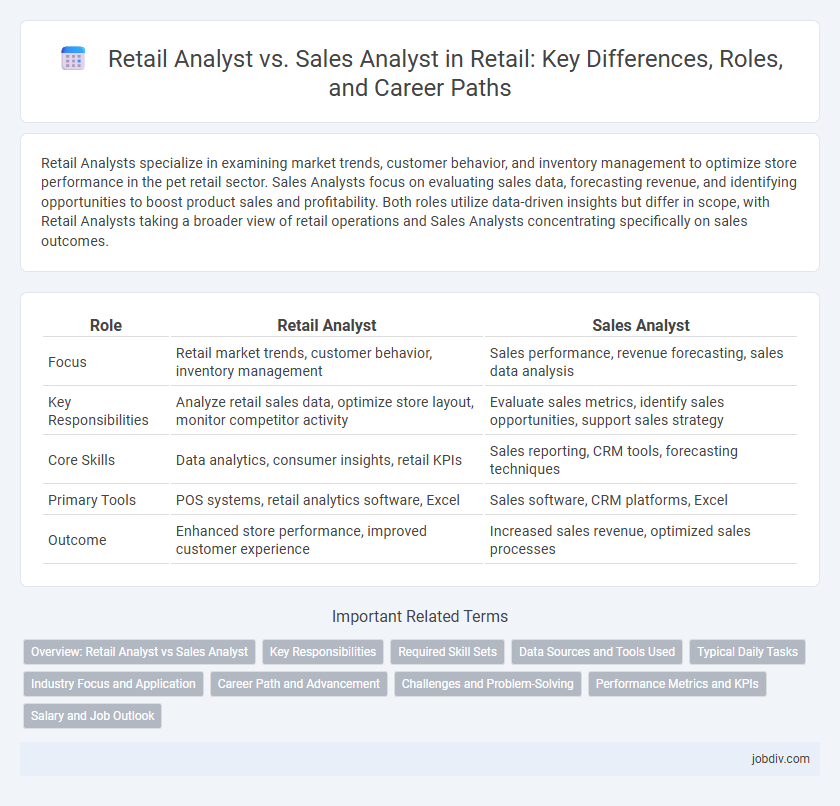Retail Analysts specialize in examining market trends, customer behavior, and inventory management to optimize store performance in the pet retail sector. Sales Analysts focus on evaluating sales data, forecasting revenue, and identifying opportunities to boost product sales and profitability. Both roles utilize data-driven insights but differ in scope, with Retail Analysts taking a broader view of retail operations and Sales Analysts concentrating specifically on sales outcomes.
Table of Comparison
| Role | Retail Analyst | Sales Analyst |
|---|---|---|
| Focus | Retail market trends, customer behavior, inventory management | Sales performance, revenue forecasting, sales data analysis |
| Key Responsibilities | Analyze retail sales data, optimize store layout, monitor competitor activity | Evaluate sales metrics, identify sales opportunities, support sales strategy |
| Core Skills | Data analytics, consumer insights, retail KPIs | Sales reporting, CRM tools, forecasting techniques |
| Primary Tools | POS systems, retail analytics software, Excel | Sales software, CRM platforms, Excel |
| Outcome | Enhanced store performance, improved customer experience | Increased sales revenue, optimized sales processes |
Overview: Retail Analyst vs Sales Analyst
Retail Analysts specialize in examining consumer behavior, market trends, and inventory metrics within the retail industry to optimize product assortment and store performance. Sales Analysts concentrate on analyzing sales data, forecasting revenue, and identifying sales opportunities across various channels to enhance overall sales strategies. Both roles leverage data analytics but differ in focus: Retail Analysts provide insights on retail operations and customer preferences, while Sales Analysts emphasize sales performance and financial outcomes.
Key Responsibilities
Retail Analysts focus on market trends, consumer behavior, and inventory management to optimize store performance and product placement. Sales Analysts concentrate on sales data analysis, revenue forecasting, and performance metrics to identify growth opportunities and improve sales strategies. Both roles utilize data analytics but apply insights to distinct aspects of retail operations.
Required Skill Sets
Retail analysts require strong expertise in consumer behavior, market trends, and inventory management, leveraging data analytics tools such as SQL and Python to optimize product assortment and pricing strategies. Sales analysts focus on sales data interpretation, forecasting, CRM software proficiency, and performance metrics analysis to drive revenue growth and sales team effectiveness. Both roles demand advanced Excel skills, critical thinking, and the ability to translate complex data into actionable business insights.
Data Sources and Tools Used
Retail analysts primarily use point-of-sale (POS) systems, inventory management software, and customer loyalty programs to gather data, leveraging tools like Tableau and SAS for advanced retail trend analysis and demand forecasting. Sales analysts rely heavily on CRM systems, sales performance databases, and market research reports, utilizing Excel, Power BI, and Salesforce analytics to track sales metrics and optimize sales strategies. Both roles employ SQL for data querying but differ in their focus areas, with retail analysts emphasizing consumer behavior insights while sales analysts concentrate on sales pipeline and revenue growth.
Typical Daily Tasks
Retail Analysts primarily focus on analyzing sales data, inventory levels, and consumer behavior to optimize product assortment and pricing strategies. Sales Analysts concentrate on evaluating sales performance, forecasting revenue, and tracking key performance indicators (KPIs) to support sales team efficiency and goal achievement. Both roles rely heavily on data interpretation and reporting but differ in their specific focus areas within the retail ecosystem.
Industry Focus and Application
Retail Analysts concentrate on analyzing consumer behavior, market trends, and inventory management within the retail sector to optimize product placement and pricing strategies. Sales Analysts focus on evaluating sales performance data and forecasting revenue across various industries, enabling targeted sales strategies and performance improvements. Both roles utilize data analytics but differ in application: Retail Analysts prioritize industry-specific metrics like foot traffic and SKU performance, while Sales Analysts emphasize broader sales metrics such as conversion rates and sales pipeline efficiency.
Career Path and Advancement
Retail analysts specialize in evaluating market trends, consumer behavior, and inventory management to optimize retail operations, positioning them for advancement into roles like Retail Manager or Merchandise Planner. Sales analysts focus on interpreting sales data, forecasting revenue, and identifying sales opportunities, which can lead to career growth as Sales Managers or Business Development Specialists. Both career paths offer advancement through expertise in data analytics, with retail analysts emphasizing operational strategy and sales analysts driving revenue growth.
Challenges and Problem-Solving
Retail analysts navigate complex consumer behavior data and inventory fluctuations to optimize product assortment and pricing strategies, addressing challenges such as seasonal demand shifts and supply chain disruptions. Sales analysts focus on evaluating sales performance metrics and forecasting revenue trends to identify underperforming products and market opportunities, solving problems related to sales targets and competitive positioning. Both roles require advanced data interpretation skills and cross-functional collaboration to ensure actionable insights drive business growth.
Performance Metrics and KPIs
Retail Analysts focus on metrics such as inventory turnover, foot traffic, and customer conversion rates to optimize store performance and product assortment. Sales Analysts prioritize KPIs like revenue growth, average transaction value, and sales pipeline efficiency to drive revenue and forecast future sales trends. Both roles utilize data analytics but differ in emphasis--Retail Analysts target operational performance, while Sales Analysts concentrate on sales effectiveness and market demand.
Salary and Job Outlook
Retail analysts typically earn an average salary of $65,000 per year, with growth projections of 7% over the next decade, driven by increasing demand for consumer behavior insights. Sales analysts earn slightly less, around $60,000 annually, but benefit from broader opportunities in various industries, contributing to a steady job outlook estimated at 6% growth. Both roles emphasize data analysis skills, yet retail analysts often command higher salaries due to their specialized market knowledge and influence on retail strategy.
Retail Analyst vs Sales Analyst Infographic

 jobdiv.com
jobdiv.com